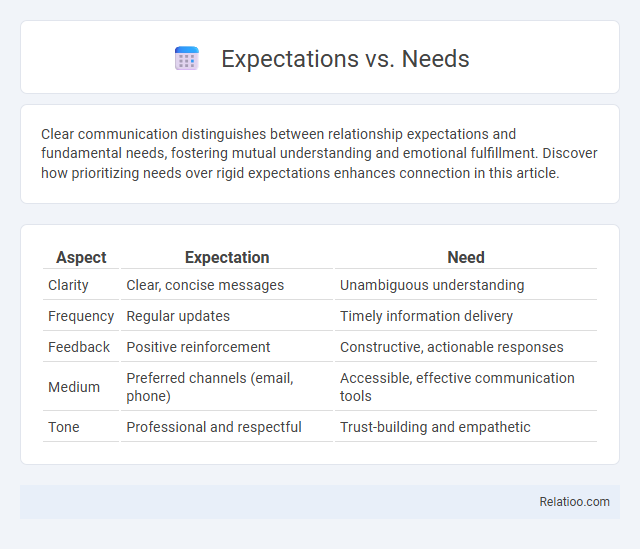Clear communication distinguishes between relationship expectations and fundamental needs, fostering mutual understanding and emotional fulfillment. Discover how prioritizing needs over rigid expectations enhances connection in this article.
Table of Comparison
| Aspect | Expectation | Need |
|---|---|---|
| Clarity | Clear, concise messages | Unambiguous understanding |
| Frequency | Regular updates | Timely information delivery |
| Feedback | Positive reinforcement | Constructive, actionable responses |
| Medium | Preferred channels (email, phone) | Accessible, effective communication tools |
| Tone | Professional and respectful | Trust-building and empathetic |
Understanding Expectations vs Needs
Understanding expectations versus needs is crucial for effective communication and personal fulfillment. Expectations often stem from preconceived notions or desires about how situations or people should behave, while needs represent essential requirements for well-being and satisfaction. By clearly distinguishing your expectations from your fundamental needs, you can better manage relationships and avoid unnecessary conflicts or disappointments.
The Psychology Behind Expectations
Understanding the psychology behind expectations reveals how your mind distinguishes between what you desire (needs) and what you anticipate (expectations). Expectations often shape emotional responses more than actual needs, influencing satisfaction and motivation in personal and professional contexts. Managing these mental frameworks effectively improves decision-making and emotional well-being by aligning realistic outcomes with your core needs.
Identifying Core Human Needs
Identifying core human needs involves distinguishing between expectations, which are anticipations of specific outcomes, and fundamental needs, such as safety, belonging, and self-esteem that drive behavior. Your ability to recognize these underlying needs allows for more effective communication and fulfillment in personal and professional relationships. Understanding this difference helps in addressing true motivations rather than surface-level desires.
How Expectations Shape Experiences
Expectations profoundly influence how you perceive and interpret experiences, often shaping emotional responses and satisfaction levels. When expectations align with actual needs, experiences tend to feel more fulfilling and meaningful, enhancing overall well-being. Misaligned expectations can lead to disappointment, highlighting the importance of managing and understanding your anticipations to create positive outcomes.
The Gap Between Expectations and Reality
The gap between expectations and reality often arises when anticipated outcomes do not align with actual experiences, leading to dissatisfaction or unmet needs. Understanding this discrepancy involves analyzing cognitive biases, emotional responses, and situational factors influencing perception. Bridging this gap requires managing expectations through clear communication, realistic goal-setting, and continuous feedback loops in personal or professional contexts.
Meeting Needs Versus Fulfilling Wants
Meeting your needs involves addressing fundamental requirements essential for well-being, such as safety, health, and basic comforts, whereas fulfilling wants pertains to desires influenced by personal preferences or societal trends. Needs are non-negotiable necessities grounded in survival and function, while wants are flexible and often driven by emotional satisfaction or status. Prioritizing unmet needs ensures stability and growth, making it crucial to discern and balance these elements effectively.
Managing Disappointment and Satisfaction
Managing disappointment and satisfaction requires a clear understanding of the differences between expectations, needs, and wants. Your needs are essential and non-negotiable for well-being, while expectations are beliefs about outcomes that may or may not be realistic, and wants are desires that enhance satisfaction but are not necessary. By aligning your expectations with your actual needs and recognizing the distinction from wants, you can effectively reduce disappointment and increase overall contentment.
Reframing Expectations for Personal Growth
Reframing expectations for personal growth involves shifting your mindset from rigid demands to flexible needs, allowing you to adapt and thrive in changing circumstances. Understanding the distinction between your expectations and true needs helps you set realistic goals that foster resilience and self-improvement. Aligning your perspective in this way empowers you to embrace challenges as opportunities for growth rather than sources of disappointment.
Balancing Expectations and Realistic Needs
Balancing expectations and realistic needs requires understanding the difference between desired outcomes and essential requirements. Prioritizing needs ensures sustainable satisfaction, while managing expectations helps prevent disappointment and fosters healthier relationships. Clear communication and self-awareness are key to aligning goals with achievable results.
Practical Steps to Align Expectations with Needs
Clarifying your needs versus expectations starts with identifying what is essential versus what is desired in any situation. Prioritize open communication to express these distinctions clearly with relevant parties, ensuring mutual understanding and realistic goal setting. Regularly reassess and adjust your expectations based on evolving needs to maintain alignment and avoid frustration.

Infographic: Expectation vs Needs
 relatioo.com
relatioo.com